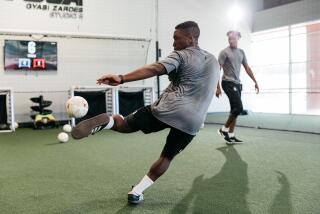For Sports-Oriented Adults, Keeping Fit Is a Team Effort
- Share via
Adults are discovering that you don’t have to be a kid to recapture the thrill of playing team sports.
A new nationwide study from the Sporting Goods Manufacturers Assn., which monitors 102 sports and fitness activities, found that the popularity of adult recreation and team sports is up 22% over 1999.
Michele Smartt, a Texas mother of three young boys, is among the team players. After years of carpooling her sons to after-school soccer and basketball games, Smartt and other parents who coach or cheer on their kids from the sidelines formed sports teams of their own.
Three weeks into the season, Smartt notes, “My fitness level has improved, I talk soccer strategies and run drills with my kids, and how can I beat the convenience--and the pleasure--of playing on the field next to my sons?”
Taking up an entirely new activity, especially something you never thought you’d do, is a great way to tweak your regular fitness routine.
And the social environment of a team offers a way to reconnect in this age of e-mail, Palm Pilots and voice mail.
Smartt’s teammate Donna Harper says, “I go to the gym three days a week, but joining a soccer team motivates me to exercise on Saturday mornings. I used to stick around the house after my weekend chores, but with my teammates depending on me to play center forward, I can’t pull a no-show.”
Their team has now won two games and lost two. Smartt says, “Even though I ache in parts of my body I didn’t know existed, I’m enjoying every minute of playing on this team. I feel much fitter all around.”
Once you’ve made up your mind to join a team, dedicate a few extra minutes each day getting your body ready before you step up to the plate or onto the court. These simple exercises will keep you on top of your game and off the injury list.
Tennis: Be prepared for a full-body workout. Start by strengthening your legs.
Most people think the game is all about arm strength, says Maureen Stanton, a sports training coach at Winning Habits.com, a fitness consultant in Dallas. “But the power of your swing should start at ground level and work its way up through your body.” Lunges will improve your side shuffling, your play in the ready position, and your stability in grabbing those low volleys.
* Lunge: Stand with your feet shoulder-width apart, then step forward with your right foot so that it’s about three feet in front of your left foot. Bend your knee and lunge forward. Step back and repeat the movement with the other leg. When you lunge forward, your front foot should land on your flat heel with your knee bent. Your rear leg should be almost straight and you should be on the ball of your rear foot rather than the heel. Carrying light weights in your hands while you lunge will build additional strength in your thighs and glutes. Do 12 to 15 repetitions, alternating each leg to ensure that neither leg gets too tired. Try to complete three sets three times a week.
Softball and baseball: Flexibility is important for both of these all-American sports. You stand around in the outfield and, before you know it, you’re stepping up to the plate. To stay flexible--and avoid pulled muscles--concentrate on stretching your hamstrings (back of thigh), hip-flexor muscles (front of hip) and shoulders before and after your game to avoid injuries.
* Hip-flexor stretch: Stand with your legs shoulder-width apart, knees slightly bent, and place your hands on your rear with fingers pointing toward the floor. Slowly and gently arch your back and push your hips forward. Gradually slide your hands down past your rear. Open your chest muscles and press your elbows together at your back as you hold the stretch. Hold it for about 30 seconds and breathe through the movement. Do this for a few minutes each day.
Basketball: Agility skills are very important, so incorporate some plyometric exercises (applying speed to strength) to your training regimen. These movements will make you a little stronger and a lot faster. Try a side-to-side box shuffle and a jump-and-reach. Also, add some cardiovascular conditioning. A stationary bike can increase your stamina and improve leg, hip and gluteus strength. Another important principle for basketball is stretching. Concentrate on stretching your calf muscles after your warmup and your workout.
* Calf stretch: Place your hands on a wall (a tree is fine too), slide your right leg back two or three feet and lean forward onto your left leg, knee bent. Straighten your right leg and firmly press the heel onto the floor or ground while letting the hip come forward. Repeat with your left leg.
Soccer: Predominantly a cardiovascular game, this sport requires bursts of energy throughout each quarter. The majority of your preconditioning should be strengthening your heart and lungs.
* Sprints: Sprinting the soccer field three to five times with a minute’s rest in between will improve your condition. Start out with these sprints twice a week and work up to three times a week. Additionally, be sure you warm up, not just stretch, before a game. Breaking a sweat to elevate your body temperature will prepare your muscles for use.
*
Tip: Wear sport-specific athletic shoes when hitting field or court, and be sure they fit properly.
* Tennis shoes should have an “Achilles’ notch,” or groove, in the back of the ankle that protects the Achilles’ tendon and prevents irritation.
* Basketball shoes should have plenty of ankle support for protection against twists or sprains.
* For soccer, invest in a pair of molded cleats or a ribbed sole.
* Softball and baseball shoes should be sturdy but primarily fit for running the bases. I’m also a big fan of a helmet when you step up to the plate.
*
Stephanie Oakes is a fitness correspondent for Discovery Health Channel. She can be reached by e-mail at stephoakes@aol.com.


